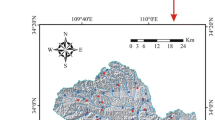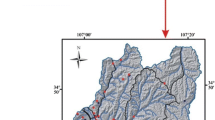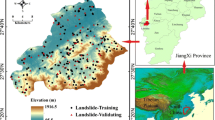Abstract
The main purpose of the present study is to compare the prediction capability of frequency ratio (FR), index of entropy (IOE), and support vector machines with four kernel functions (LN-SVM, PL-SVM, RBF-SVM, and Sig-SVM) for landslide susceptibility mapping at Long County, China. For this purpose, a total of 171 landslide locations were collected from historical landslide reports, interpretation of satellite images, and field survey data. These landslides were separated into two parts (70/30): 120 landslides were randomly selected for training the models, and the remaining 51 landslides were used for validation purpose. Eleven landslide-related parameters were selected to produce landslide susceptibility maps, including slope aspect, slope angle, plan curvature, profile curvature, altitude, NDVI, land use, distance to faults, distance to roads, distance to rivers, and lithology. The landslide susceptibility maps were produced by FR, IOE, and SVM models, and these maps were validated and compared using area under the curve method. The results show that the RBF-SVM model has the best performance for this study area, while the success rate is 82.51 % and prediction rate is 77.83 %. For the other models, the results are as follows: the PL-SVM model (success rate is 82.44 %; prediction rate is 75.71 %), the FR model (success rate is 79.79 %; prediction rate 75.42 %), the LN-SVM model (success rate is 79.76 %; prediction rate is 74.76 %), the IOE model (success rate is 78.29 %; prediction rate is 74.01 %), and the Sig-SVM model (success rate is 75.22 %; prediction rate is 73.75 %). The results of this study are useful for land-use decision makers, landslide risk assessment and management study in this region, and other similar areas.









Similar content being viewed by others
References
Akgun A, Sezer EA, Nefeslioglu HA, Gokceoglu C, Pradhan B (2012) An easy-to-use MATLAB program (MamLand) for the assessment of landslide susceptibility using a Mamdani fuzzy algorithm. Comput Geosci 38(1):23–34
Aleotti P, Chowdhury R (1999) Landslide hazard assessment: summary review and new perspectives. Bull Eng Geol Environ 58(1):21–44
Bui Tien, Lofman O, Revhaug I, Dick O (2011) Landslide susceptibility analysis in the Hoa Binh province of Vietnam using statistical index and logistic regression. Nat Hazards 59(3):1413–1444
Bui Tien, Pradhan B, Lofman O, Revhaug I, Dick OB (2013) Regional prediction of landslide hazard using probability analysis of intense rainfall in the Hoa Binh province, Vietnam. Nat Hazards 66(2):707–730
Bui Tien, Tuan TA, Klempe H, Pradhan B, Revhaug I (2015) Spatial prediction models for shallow landslide hazards: a comparative assessment of the efficacy of support vector machines, artificial neural networks, kernel logistic regression, and logistic model tree. Landslides. doi:10.1007/s10346-015-0557-6
Cevik E, Topal T (2003) GIS-based landslide susceptibility mapping for a problematic segment of the natural gas pipeline, Hendek (Turkey). Environ Geol 44(8):949–962
Chen T, Niu RQ, Li PX, Zhang LP, Du B (2011a) Regional soil erosion risk mapping using RUSLE, GIS, and remote sensing: a case study in Miyun Watershed, North China. Environ Earth Sci 63(3):533–541
Chen T, Niu RQ, Wang Y, Li PX, Zhang LP, Du B (2011b) Assessment of spatial distribution of soil loss over the upper basin of Miyun reservoir in China based on RS and GIS techniques. Environ Monit Assess 179(1–4):605–617
Chen W, Li WP, Hou EK, Zhao Z, Deng ND, Bai HY, Wang DZ (2014) Landslide susceptibility mapping based on GIS and information value model for the Chencang District of Baoji, China. Arab J Geosci 7:4499–4511
Chen W, Li WP, Hou EK, Bai HY, Chai HC, Wang DZ, Cui XL, Wang QQ (2015) Application of frequency ratio, statistical index, and index of entropy models and their comparison in landslide susceptibility mapping for the Baozhong Region of Baoji, China. Arab J Geosci 8:1829–1841
Chen W, Chai H, Sun X, Wang Q, Ding X, Hong H (2016a) A GIS-based comparative study of frequency ratio, statistical index and weights-of-evidence models in landslide susceptibility mapping. Arab J Geosci 9(3):1–16
Chen W, Pourghasemi HR, Zhao Z (2016b) A GIS-based comparative study of Dempster-Shafer, logistic regression, and artificial neural network models for landslide susceptibility mapping. Geocarto Int. doi:10.1080/10106049.2016.1140824
Choi J, Oh HJ, Lee HJ, Lee C, Lee S (2012) Combining landslide susceptibility maps obtained from frequency ratio, logistic regression, and artificial neural network models using ASTER images and GIS. Eng Geol 124:12–23
Constantin M, Bednarik M, Jurchescu MC, Vlaicu M (2011) Landslide susceptibility assessment using the bivariate statistical analysis and the index of entropy in the Sibiciu Basin (Romania). Environ Earth Sci 63(2):397–406
Dai FC, Lee CF, Li J, Xu ZW (2001) Assessment of landslide susceptibility on the natural terrain of Lantau Island, Hong Kong. Environ Geol 40(3):381–391
Demir G, Aytekin M, Akgün A, İkizler SB, Tatar O (2013) A comparison of landslide susceptibility mapping of the eastern part of the North Anatolian Fault Zone (Turkey) by likelihood-frequency ratio and analytic hierarchy process methods. Nat Hazards 65(3):1481–1506
Devkota KC, Regmi AD, Pourghasemi HR, Yoshida K, Pradhan B, Ryu IC, Dhital MR, Althuwaynee OF (2013) Landslide susceptibility mapping using certainty factor, index of entropy and logistic regression models in GIS and their comparison at Mugling-Narayanghat road section in Nepal Himalaya. Nat Hazards 65(1):135–165
Grozavu A, Pleşcan S, Patriche CV, Mărgărint MC, Roşca B (2013) Landslide susceptibility assessment: GIS application to a complex mountainous environment. In: The carpathians: integrating nature and society towards sustainability. Springer, Berlin, Heidelberg, pp 31–44
Guettouche MS (2013) Modeling and risk assessment of landslides using fuzzy logic. Application on the slopes of the Algerian Tell (Algeria). Arab J Geosci 6(9):3163–3173
Hoang ND, Tien Bui D (2016) A novel relevance vector machine classifier with cuckoo search optimization for spatial prediction of landslides. J Comput Civil Eng. doi:10.1061/(ASCE)CP.1943-5487.0000557
Hong H, Pradhan B, Xu C, Tien Bui D (2015a) Spatial prediction of landslide hazard at the Yihuang area (China) using two-class kernel logistic regression, alternating decision tree and support vector machines. Catena 133:266–281
Hong H, Xu C, Revhaug I, Tien Bui D (2015b) Spatial prediction of landslide hazard at the Yihuang Area (China): a comparative study on the predictive ability of backpropagation multi-layer perceptron neural networks and radial basic function neural networks. In: Robbi Sluter C, Madureira Cruz CB, Leal de Menezes PM (eds) Cartography—maps connecting the world. Springer International Publishing, New York, pp 175–188
Hong H, Chen W, Xu C, Youssef AM, Pradhan B, Tien Bui D (2016a) Rainfall-induced landslide susceptibility assessment at the Chongren area (China) using frequency ratio, certainty factor, and index of entropy. Geocarto Int 1–16. doi:10.1080/10106049.2015.1130086
Hong H, Pourghasemi HR, Pourtaghi ZS (2016b) Landslide susceptibility assessment in Lianhua County (China): a comparison between a random forest data mining technique and bivariate and multivariate statistical models. Geomorphology 259:105–118
Kanungo DP, Sarkar S, Sharma S (2011) Combining neural network with fuzzy, certainty factor and likelihood ratio concepts for spatial prediction of landslides. Nat Hazards 59(3):1491–1512
Lee S (2007) Application and verification of fuzzy algebraic operators to landslide susceptibility mapping. Environ Geol 52(4):615–623
Lee S, Talib JA (2005) Probabilistic landslide susceptibility and factor effect analysis. Environ Geol 47(7):982–990
Nefeslioglu HA, Duman TY, Durmaz S (2008a) Landslide susceptibility mapping for a part of tectonic Kelkit Valley (Eastern Black Sea region of Turkey). Geomorphology 94(3):401–418
Nefeslioglu HA, Gokceoglu C, Sonmez H (2008b) An assessment on the use of logistic regression and artificial neural networks with different sampling strategies for the preparation of landslide susceptibility maps. Eng Geol 97(3):171–191
Nourani V, Pradhan B, Ghaffari H, Sharifi SS (2014) Landslide susceptibility mapping at Zonouz Plain, Iran using genetic programming and comparison with frequency ratio, logistic regression, and artificial neural network models. Nat Hazards 71(1):523–547
Oh HJ, Lee S (2011) Landslide susceptibility mapping on Panaon Island, Philippines using a geographic information system. Environ Earth Sci 62(5):935–951
Ozdemir A, Altural T (2013) A comparative study of frequency ratio, weights of evidence and logistic regression methods for landslide susceptibility mapping: sultan Mountains, SW Turkey. J Asian Earth Sci 64:180–197
Pareek N, Sharma ML, Arora MK (2010) Impact of seismic factors on landslide susceptibility zonation: a case study in part of Indian Himalayas. Landslides 7(2):191–201
Park S, Choi C, Kim B, Kim J (2013) Landslide susceptibility mapping using frequency ratio, analytic hierarchy process, logistic regression, and artificial neural network methods at the Inje area, Korea. Environ Earth Sci 68(5):1443–1464
Poudyal CP, Chang C, Oh HJ, Lee S (2010) Landslide susceptibility maps comparing frequency ratio and artificial neural networks: a case study from the Nepal Himalaya. Environ Earth Sci 61(5):1049–1064
Pourghasemi HR, Pradhan B, Gokceoglu C (2012) Application of fuzzy logic and analytical hierarchy process (AHP) to landslide susceptibility mapping at Haraz watershed, Iran. Nat Hazards 63(2):965–996
Pourghasemi HR, Moradi HR, Aghda SF (2013a) Landslide susceptibility mapping by binary logistic regression, analytical hierarchy process, and statistical index models and assessment of their performances. Nat Hazards 69(1):749–779
Pourghasemi HR, Jirandeh AG, Pradhan B, Xu C, Gokceoglu C (2013b) Landslide susceptibility mapping using support vector machine and GIS at the Golestan Province, Iran. J Earth Syst Sci 122(2):349–369
Pradhan B (2010) Landslide susceptibility mapping of a catchment area using frequency ratio, fuzzy logic and multivariate logistic regression approaches. J Indian Soc Remote Sens 38(2):301–320
Pradhan B, Youssef AM (2010) Manifestation of remote sensing data and GIS on landslide hazard analysis using spatial-based statistical models. Arab J Geosci 3(3):319–326
Pradhan B, Abokharima MH, Jebur MN, Tehrany MS (2014) Land subsidence susceptibility mapping at Kinta Valley (Malaysia) using the evidential belief function model in GIS. Nat Hazards 73(2):1019–1042
Regmi AD, Devkota KC, Yoshida K, Pradhan B, Pourghasemi HR, Kumamoto T, Akgun A (2014) Application of frequency ratio, statistical index, and weights-of-evidence models and their comparison in landslide susceptibility mapping in Central Nepal Himalaya. Arab J Geosci 7(2):725–742
Sharma M, Kumar R (2008) GIS-based landslide hazard zonation: a case study from the Parwanoo area, Lesser and Outer Himalaya, HP, India. Bull Eng Geol Environ 67(1):129–137
Sharma LP, Patel N, Ghose MK, Debnath P (2013) Synergistic application of fuzzy logic and geo-informatics for landslide vulnerability zonation—a case study in Sikkim Himalayas, India. Appl Geomat 5(4):271–284
Tien Bui D, Pradhan B, Lofman O, Revhaug I (2012a) Landslide susceptibility assessment in Vietnam using support vector machines, decision tree and Naïve Bayes models. Math Probl Eng 2012:1–26
Tien Bui D, Pradhan B, Lofman O, Revhaug I, Dick OB (2012b) 2012 Application of support vector machines in landslide susceptibility assessment for the Hoa Binh province (Vietnam) with kernel functions analysis. In: Seppelt R, Voinov AA, Lange S, Bankamp D (eds) Proceedings of the iEMSs sixth biennial meeting,: international congress on environmental modelling and software (iEMSs 2012). International Environmental Modelling and Software Society, Leipzig
Tien Bui D, Pradhan B, Revhaug I, Trung Tran C (2014) A comparative assessment between the application of fuzzy unordered rules induction algorithm and J48 decision tree models in spatial prediction of shallow landslides at Lang Son city Vietnam. In: Srivastava PK, Mukherjee S, Gupta M, Islam T (eds) Remote sensing applications in environmental research. Springer International Publishing, New york, pp 87–111
Tunusluoglu MC, Gokceoglu C, Nefeslioglu HA, Sonmez H (2008) Extraction of potential debris source areas by logistic regression technique: a case study from Barla, Besparmak and Kapi mountains (NW Taurids, Turkey). Environ Geol 54(1):9–22
Vapnik VN, Vapnik V (1998) Statistical learning theory, vol 1. Wiley, New York
Xu C, Dai F, Xu X, Lee YH (2012a) GIS-based support vector machine modeling of earthquake-triggered landslide susceptibility in the Jianjiang River watershed, China. Geomorphology 145:70–80
Xu C, Xu X, Dai F, Saraf AK (2012b) Comparison of different models for susceptibility mapping of earthquake triggered landslides related with the 2008 Wenchuan earthquake in China. Comput Geosci 46:317–329
Yalcin A, Reis S, Aydinoglu AC, Yomralioglu T (2011) A GIS-based comparative study of frequency ratio, analytical hierarchy process, bivariate statistics and logistics regression methods for landslide susceptibility mapping in Trabzon, NE Turkey. Catena 85(3):274–287
Yilmaz C, Topal T, Süzen ML (2012) GIS-based landslide susceptibility mapping using bivariate statistical analysis in Devrek (Zonguldak-Turkey). Environ Earth Sci 65(7):2161–2178
Youssef AM, Al-Kathery M, Pradhan B (2014) Landslide susceptibility mapping at Al-Hasher area, Jizan (Saudi Arabia) using GIS-based frequency ratio and index of entropy models. Geosci J 19(1):113–134
Youssef AM, Pourghasemi HR, El-Haddad BA, Dhahry BK (2015) Landslide susceptibility maps using different probabilistic and bivariate statistical models and comparison of their performance at Wadi Itwad Basin, Asir Region, Saudi Arabia. Bull Eng Geol Environ. doi:10.1007/s10064-015-0734-9
Yufeng S, Fengxiang J (2009) Landslide stability analysis based on generalized information entropy. In: Environmental science and information application technology, 2009. ESIAT 2009. International conference on. Vol 2. IEEE, pp 83–85
Acknowledgments
The authors would like to thank the anonymous reviewers and J.W. Lamoreaux (Editor Environmental Earth Sciences) for their helpful comments on the manuscript. This research was supported by the Doctoral Scientific Research Foundation of Xi’an University of Science and Technology (Grant No. 2015QDJ067) and General Program of Jiangxi Meteorological Bureau.
Author information
Authors and Affiliations
Corresponding author
Rights and permissions
About this article
Cite this article
Chen, W., Wang, J., Xie, X. et al. Spatial prediction of landslide susceptibility using integrated frequency ratio with entropy and support vector machines by different kernel functions. Environ Earth Sci 75, 1344 (2016). https://doi.org/10.1007/s12665-016-6162-8
Received:
Accepted:
Published:
DOI: https://doi.org/10.1007/s12665-016-6162-8




